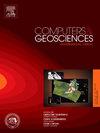Ensemble Kalman, adaptive Gaussian mixture, and particle flow filters for optimized earthquake occurrence estimation
IF 4.2
2区 地球科学
Q1 COMPUTER SCIENCE, INTERDISCIPLINARY APPLICATIONS
引用次数: 0
Abstract
Probabilistic forecasts are regarded as the highest achievable goal when predicting earthquakes, but limited information on stress, strength, and governing parameters of the seismogenic sources affects their accuracy. Ensemble data-assimilation methods, such as the Ensemble Kalman Filter (EnKF), estimate these variables by combining physics-based models and observations. While the EnKF has demonstrated potential in perfect model experiments using earthquake simulators governed by rate-and-state friction (RSF) laws, challenges arise from the non-Gaussian distribution of state variables during seismic cycle transitions. This study investigates the Adaptive Gaussian Mixture Filter (AGMF) and the Particle Flow Filter (PFF) as alternatives for improved stress and velocity estimation in earthquake sequences compared to Gaussian-based methods like the EnKF. We test the AGMF and the PFF’s performance using Lorenz 96 and Burridge–Knopoff 1D models which are, respectively, standard simplified atmospheric and earthquake models. This approach, using widely recognized and commonly used testbed models in their fields, makes the methods and findings accessible to both the data assimilation and seismology communities, while supporting comparisons and collaboration. We test these models in periodic, and aperiodic conditions, and analyze the impact of assuming Gaussian priors on the estimates of the ensemble methods. The PFF demonstrated comparable performance in chaotic scenarios, yielding lower RMSE for the estimates of the Lorenz 96 models and stronger resilience to underdispersion for the Burridge–Knopoff 1D models. This is vital given the limited and sparse historical earthquake data, underscoring the PFF’s potential in enhancing earthquake forecasting. These results emphasize the need for careful data assimilation method selection in seismological modeling.
集合卡尔曼,自适应高斯混合,和粒子流滤波器优化地震发生估计
概率预报被认为是预测地震时可达到的最高目标,但是关于发震源的应力、强度和控制参数的有限信息影响了其准确性。集成数据同化方法,如集成卡尔曼滤波(EnKF),通过结合基于物理的模型和观测来估计这些变量。虽然EnKF在使用速率和状态摩擦(RSF)定律控制的地震模拟器进行完美模型实验中显示了潜力,但在地震周期转换期间,状态变量的非高斯分布带来了挑战。本研究探讨了自适应高斯混合滤波器(AGMF)和粒子流滤波器(PFF)作为地震序列中改进应力和速度估计的替代方法,与基于高斯的方法(如EnKF)相比。我们分别使用Lorenz 96和Burridge-Knopoff一维模型(分别是标准简化的大气模型和地震模型)来测试AGMF和PFF的性能。这种方法在各自的领域使用广泛认可和常用的试验台模型,使数据同化和地震学社区都可以使用方法和发现,同时支持比较和协作。我们在周期和非周期条件下测试了这些模型,并分析了假设高斯先验对集合方法估计的影响。PFF在混沌情况下表现出相当的性能,对Lorenz 96模型的估计产生更低的RMSE,对Burridge-Knopoff 1D模型的欠色散具有更强的弹性。鉴于有限和稀疏的历史地震数据,这一点至关重要,强调了PFF在加强地震预报方面的潜力。这些结果强调了在地震模拟中需要仔细选择数据同化方法。
本文章由计算机程序翻译,如有差异,请以英文原文为准。
求助全文
约1分钟内获得全文
求助全文
来源期刊

Computers & Geosciences
地学-地球科学综合
CiteScore
9.30
自引率
6.80%
发文量
164
审稿时长
3.4 months
期刊介绍:
Computers & Geosciences publishes high impact, original research at the interface between Computer Sciences and Geosciences. Publications should apply modern computer science paradigms, whether computational or informatics-based, to address problems in the geosciences.
 求助内容:
求助内容: 应助结果提醒方式:
应助结果提醒方式:


